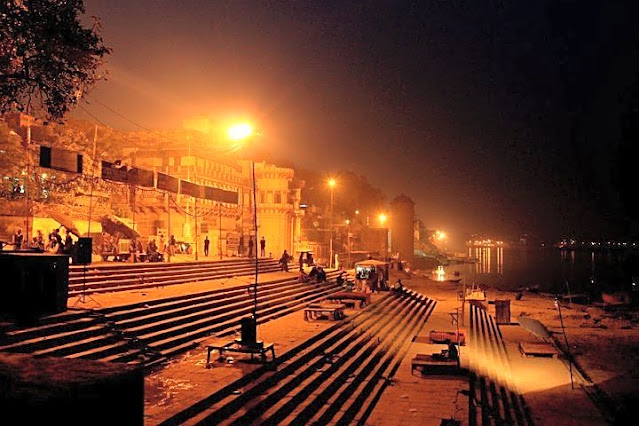- The Ghats
The Ganges River is one of India's most cherished natural wonders, named after the Hindu goddess Ganga. From the Himalayas in the north to the Bay of Bengal, the river flows southeast. The Ganges River supplies water to between 400 million and 600 million people on a daily basis for bathing and drinking.
Hindus travel from all over the world to Varanasi to purify themselves in the sacred Ganges water and perform ceremonies along the river's thousands of ghats. The Ganges provides a permanent point of orientation for travellers navigating throughout the city, and you'll undoubtedly spend a lot of time sightseeing and watching life go by along its banks.
- Dasaswamedh Ghat
The Dasaswamedh Ghat is one of the top spots to visit in Varanasi because of its colourful ambiance.
This tourist attraction is a jumble of flower vendors boasting vibrant blooms, boat operators touting Ganges River cruises, and sadhus (holy men) wearing face paint.
During the day, you can spend hours people watching in this neighborhood.
- Assi Ghat
The city's southernmost main ghat is often at the top of the list when it comes to notable places in Varanasi. A Shiva lingam (phallic depiction of the Hindu deity) beneath a sacred fig tree is the highlight of Assi Ghat. Hundreds of pilgrims visit every day to worship Lord Shiva after a bath in the Ganges River.
- Manikarnika Ghat
At Manikarnika Ghat, plumes of smoke swirl toward the sky. It's not from a factory; it's from the continuous cremations that take place on this ghat. Manikarnika Ghat is considered by Hindus to be one of the most favourable places for the departed to attain moksha (emancipation from the cycle of spiritual rebirth). This ghat's funeral pyre burns 24 hours a day, and over 100 cremations take place each day.
Tourists are routinely offered tours of the intriguing ghat by priests or guides, but some can be aggressive in their demands for money. You might observe doms (untouchable castemembers)dragging cloth-wrapped bodies on homemade stretchers, as well as stacks of fuel ready to feed the bonfire.
It's also possible that you'll be given the opportunity to see.
At Manikarnika Ghat, plumes of smoke swirl toward the sky.
It's not from a factory; it's from the continuous cremations that take place on this ghat.
Manikarnika Ghat is considered by Hindus to be one of the most favourable places for the departed to attain moksha (emancipation from the cycle of spiritual rebirth).
This ghat's funeral pyre burns 24 hours a day, and over 100 cremations take place each day.
Tourists are routinely offered tours of the intriguing ghat by priests or guides, but some can be aggressive in their demands for money.
You might observe doms (untouchable castemembers)dragging cloth-wrapped bodies on homemade stretchers, as well as stacks of fuel ready to feed the bonfire.
It's also possible that you'll be given the opportunity to see.
- Darbhanga Ghat
Take heed, photographers: Darbhanga Ghat provides the ideal opportunity to capture stunning images of Varanasi. The ultra-luxurious BrijRama Palace, a historic fort that has subsequently been turned into a heritage hotel, crowns the stairs leading down to the riverfront. The Greek pillars and curving balconies of the home provide a regal backdrop for the region (and your photographs).
Arrive early in the morning to catch uninterrupted views of the spectacular sunrise over the Ganges River's horizon.
Location: Bangali Tola, Varanasi, near Ahilyabai Ghat











.jpeg)






0 Comments